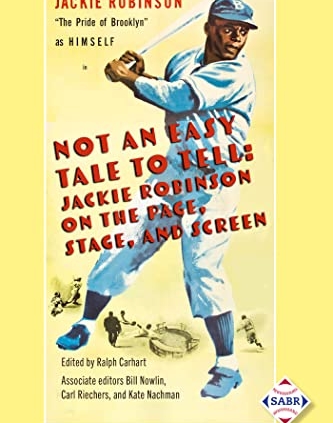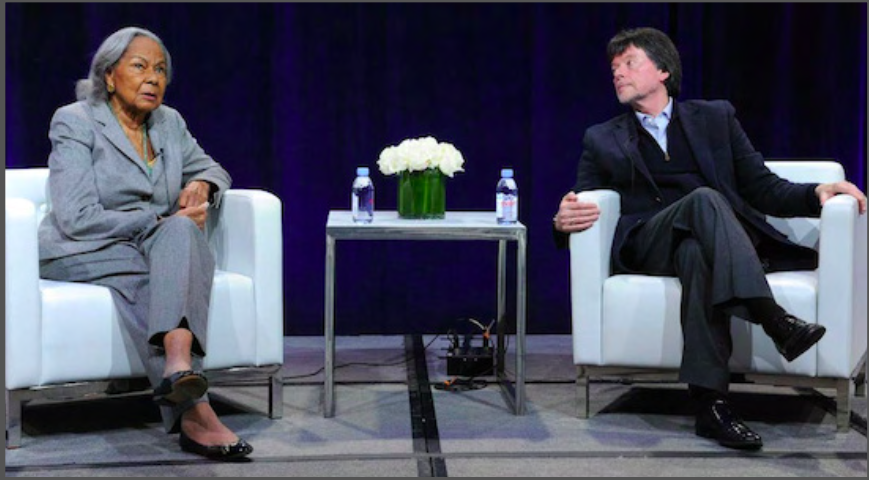Ken Burns’ Jackie Robinson
This article was written by Pat Ellington Jr.
This article was published in Not an Easy Tale to Tell: Jackie Robinson on the Page, Stage, and Screen (2022)
Rachel Robinson and Ken Burns discuss Jackie Robinson’s legacy. (Frederick M. Brown/Getty Images)
Ken Burns’s film, Jackie Robinson, perfectly fits the definition of a documentary by providing a factual record or report. As a Black member of the audience, it was extremely important for me to hear from Black people in cultural context and to see honesty about the racism embedded in America. The film production crew devoted a great deal of attention to detail, seeking out accounts from those who were close to Jackie Robinson both inside and outside of the game of baseball, including some of professional baseball’s most reputed writers and historians, politicians, and other cultural figures, all with the blessing of and cooperation with the Robinson family.
It’s easy for one to be skeptical about a White person capturing the life of a man of African descent, a man who intentionally did everything he could both publicly and privately to change the status of Black people as bottom-class citizens around the globe – someone who arguably had a revolutionary impact. Would Burns be able to grasp, or be willing to go far enough to explain, the absurdity of racism and bigotry? Would he be able to capture the fact that Jackie Robinson fought back on and off the field as often as he turned the other cheek? One wondered whether Burns would be willing to tell Jackie Robinson’s flat-out truths that contradict the myth that is the American Dream—a myth that at the time the country was founded was created to intentionally be inaccessible to Black people, an era in which at best a Black person was considered to be 3/5ths of a human being.1
Ken Burns did all this, and portrayed Robinson in an honest tone that showed who he was at the beginning and the end of the day – a fighter and trailblazer for his people. He didn’t hesitate to address some of the myths that were a product of Robinson’s extraordinary life. For instance Burns confronted the apocryphal story of Pee Wee Reese putting his arm around Robinson. He interviewed eyewitnesses who provided first-hand accounts, and pointed out the lack of photographs. In their own way, some of these fictional tales attest to the the importance and impact of Robinson. Burns, the documentarian, approached them in an honest way.
The documentary’s focus on Jackie’s wife Rachel Robinson is key to the quality of the documentary. Positioned right next to the second baseman throughout the majority of his life, it was both imperative and rewarding to feature her perspective. The extremely close relationship that the Robinsons had was evident in her recounting his life, thoughts, dreams, and fears. She saw how restless the mistreatment of Black people in America made her husband, and how he used baseball to fight against it.
Any idea that Jackie Robinson did nothing but turn the other cheek and keep silent about his mistreatment as an individual of African descent is a flagrant myth. He constantly countered certain White players, members of the press, and even heckling fans with his words, his actions, and his continued success on and off the diamond.2
There has been a “pacification” of Robinson that was meant to soften his image in hindsight, as his radicalness against racism and third-class citizenship remains challenging for a significant portion of the population. This was not the only major myth about Robinson that was officially debunked during the documentary. At the same time Burns subtly presents an important theme of the documentary— that American society needs myths and obscurations of Jackie Robinson’s image, words, and intentions, in addition to his wondrous feats on the diamond, in order for it to accept who he was.
Burns consistently looked at Robinson’s struggle to find a place within the movement he helped found, as he got older and had reaped some of the success of his efforts. He wove the first-hand accounts into the story brilliantly, using Robinson’s relationship with the New York Post as a great example. When Robinson first started writing columns at the paper, it was radical and effective. As time passed, and as the Civil Rights Movement became more militant, the flock of blades that were Robinson’s articles gradually dulled. He was soon booted from the paper as he went from criticizing conservatives to being labeled as one for his political affiliations.3
Burns does an excellent job of revealing Robinson’s struggles even further by showing his experiences and connections with other Black people who were trying to dismantle racism in the United States and abroad, and how they heavily mirror and contrast his failures negotiating with the establishment on behalf of his people. His relationship with Malik el-Shabazz (a/k/a Malcolm X), and el-Shabazz’s rhetoric for militancy and self-defense is a perfect example. Their mutual misunderstandings during the latter part of their relationship are well-known and well-covered,4 but Burns included the fruitful and productive parts of their relationship as well. El-Shabazz is on record as citing the impact of listening to the second baseman’s early career while Malcolm Little was in prison, and credits Robinson’s pathbreaking career as a huge inspiration.
Dr. Martin Luther King Jr. was another individual inspired by Jackie Robinson’s career when he was a young man and saw how baseball intersected with society. King later collaborated with Robinson and they became close confidants. This friendship helped King see the inherent revolutionism in Black baseball culture. Dr. King went on to foster a similar relationship with Afro-Puerto Rican Roberto Clemente.5
Robinson’s dismal track record with politicians on both sides of the United States political spectrum was addressed. Burns highlights Robinson’s naïveté in trusting the political establishment at face value; he undertook relationships with such a figure as Richard Nixon and the Republican Party in 1960, without leverage or an organization of his own, and crashed and burned. This relationship only looked worse when Barry Goldwater and his “Southern strategy” changed the party dramatically in the 1964 election.
One particularly important portion of the documentary demonstrated how Burns was willing to go above and beyond, and that was the inclusion of Afro-Cuban Hall of Famer Minnie Miñoso, who expressed how Robinson’s success inspired him to become the first Afro-Latino to wear a major-league baseball uniform. This emphasized how Robinson fought for and served as an example to the entire African diaspora. The histories and experiences of the various nationalities and ethnicities that comprise the African diaspora are inextricably linked, and the 150 years of history that people of African descent across the globe have with the game of baseball exemplifies that fact.6 It is one rarely covered correctly – or even mentioned by many of those deemed to be the sport’s pundits. Burns dedicated a segment to explore this topic.
All in all, this documentary accurately portrayed the highlights and shadows of an individual who has had his story distorted and twisted many times over. The lengths to which Burns went, utilizing first- and second-hand accounts from important sources while layering music, photos, and videos between interview clips was masterful. His selection of who to include and what stories they told was as well.
Burns’s acknowledgements of Robinson’s flaws were not ingenuous or solitary; they are positioned alongside his self-awareness and his dedication to being an inspiration for Black people around the globe. Robinson kept trying to overcome his own shortcomings and make up for his failures. The documentary shows us a man who knew he was not infallible, but who consistently tried to evolve as the revolution needed him to grow. Robinson would never have seen himself as a revolutionary, but as we look back on his contributions 75 years later, one could well argue that his integration of baseball helped prompt a seismic change in American society. Today, he remains one of the most visible examples of Black baseball’s inherent revolutionism. Ken Burns has successfully captured that story.
PAT ELLINGTON JR. is a journalist, screenwriter, and novelist from Northeast Ohio.
Notes
1 Malik Simba, “The Three-Fifths Clause of the United States Constitution (1787),” blackpast.org, October 3, 2014. https://www.blackpast.org/african-american-history/events-african-american-history/three-fifths-clause-united-states-constitution-1787/, accessed March 16, 2022.
2 Matt Welch, “When Jackie Robinson Fought Back,” Reason, July 2013, https://reason.com/2013/06/30/when-jackie-robinson-fought-back/, accessed March 16, 2022.
3 Matt Welch. “On Jackie Robinson Day, Let’s Remember When He Was Fired From the New York Post For Being Too Republican.” Reason, April 15, 2015, https://reason.com/2015/04/15/on-jackie-robinson-daylets-remember-whe/, accessed March 16, 2022.
4 Justin Tinsley, “Jackie Robinson vs. Malcolm X,” Andscape, May 25, 2016, https://andscape.com/features/jackie-robinson-vs-malcolm-x/, accessed March 16, 2022.
5 José de Jesus Ortiz, “Martin Luther King Jr. and Roberto Clemente Had a Deep Bond,” Our Esquina, January 17, 2022, https://ouresquina.com/2022/martin-luther-king-jr-and-roberto-clemente-had-deep-bond/, accessed March 16, 2022.
6 Library of Congress, “Drawing the Color Line: 1860s to 1890s.” https://www.loc.gov/collections/jackie-robinson-baseball/articles-and-essays/baseball-the-color-line-and-jackie-robinson/1860s-to-1890s/, accessed March 16, 2022.



